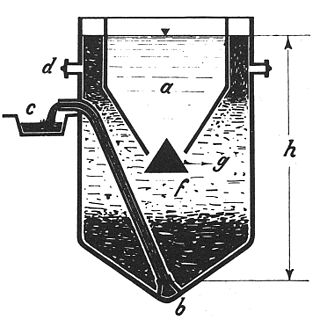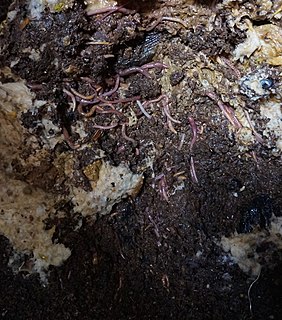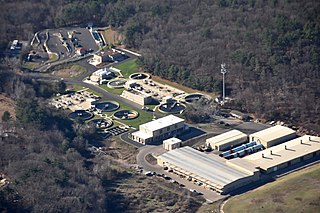
The Imhoff tank, named for German engineer Karl Imhoff (1876–1965), is a chamber suitable for the reception and processing of sewage. It may be used for the clarification of sewage by simple settling and sedimentation, along with anaerobic digestion of the extracted sludge. It consists of an upper chamber in which sedimentation takes place, from which collected solids slide down inclined bottom slopes to an entrance into a lower chamber in which the sludge is collected and digested. The two chambers are otherwise unconnected, with sewage flowing only through the upper sedimentation chamber and no flow of sewage in the lower digestion chamber. The lower chamber requires separate biogas vents and pipes for the removal of digested sludge, typically after 6-9 months of digestion. The Imhoff tank is in effect a two-story septic tank and retains the septic tank's simplicity while eliminating many of its drawbacks, which largely result from the mixing of fresh sewage and septic sludge in the same chamber.

Waste stabilization ponds are ponds designed and built for wastewater treatment to reduce the organic content and remove pathogens from wastewater. They are man-made depressions confined by earthen structures. Wastewater or "influent" enters on one side of the waste stabilization pond and exits on the other side as "effluent", after spending several days in the pond, during which treatment processes take place.

Upflow anaerobic sludge blanket (UASB) technology, normally referred to as UASB reactor, is a form of anaerobic digester that is used for wastewater treatment.
In-vessel composting generally describes a group of methods that confine the composting materials within a building, container, or vessel. In-vessel composting systems can consist of metal or plastic tanks or concrete bunkers in which air flow and temperature can be controlled, using the principles of a "bioreactor". Generally the air circulation is metered in via buried tubes that allow fresh air to be injected under pressure, with the exhaust being extracted through a biofilter, with temperature and moisture conditions monitored using probes in the mass to allow maintenance of optimum aerobic decomposition conditions.
A mechanical biological treatment system is a type of waste processing facility that combines a sorting facility with a form of biological treatment such as composting or anaerobic digestion. MBT plants are designed to process mixed household waste as well as commercial and industrial wastes.
Sequencing batch reactors (SBR) or sequential batch reactors are a type of activated sludge process for the treatment of wastewater. SBR reactors treat wastewater such as sewage or output from anaerobic digesters or mechanical biological treatment facilities in batches. Oxygen is bubbled through the mixture of wastewater and activated sludge to reduce the organic matter. The treated effluent may be suitable for discharge to surface waters or possibly for use on land.

Sewage sludge treatment describes the processes used to manage and dispose of sewage sludge produced during sewage treatment. Sludge is mostly water with lesser amounts of solid material removed from liquid sewage. Primary sludge includes settleable solids removed during primary treatment in primary clarifiers. Secondary sludge separated in secondary clarifiers includes treated sewage sludge from secondary treatment bioreactors.
An expanded granular sludge bed (EGSB) reactor is a variant of the upflow anaerobic sludge blanket digestion (UASB) concept for anaerobic wastewater treatment. The distinguishing feature is that a faster rate of upward-flow velocity is designed for the wastewater passing through the sludge bed. The increased flux permits partial expansion (fluidisation) of the granular sludge bed, improving wastewater-sludge contact as well as enhancing segregation of small inactive suspended particle from the sludge bed. The increased flow velocity is either accomplished by utilizing tall reactors, or by incorporating an effluent recycle. A scheme depicting the EGSB design concept is shown in this EGSB diagram.
A hybrid biological reactor (HBR) was developed which involved the introduction of a new phase of attached-biomass into a regular suspended-growth system by addition of carriers to
The anaerobic contact process is a type of anaerobic digester. Here a set of reactors are created in series, often with recycling. This recycled material is pumped up into the bottom of the first reactor, an upflow reactor. The upflow anaerobic process is a large reactor which allows the waste to flow up from the bottom and separates the waste into 3 zones. At the very top is the biogas zone where the gas is collected. Bacteria digest waste in the lowest portion of the upflow reactor; the bioreactor zone. In between these two stages is the clarifier zone where which exports the stabilised waste.
An aerobic treatment system or ATS, often called (incorrectly) an aerobic septic system, is a small scale sewage treatment system similar to a septic tank system, but which uses an aerobic process for digestion rather than just the anaerobic process used in septic systems. These systems are commonly found in rural areas where public sewers are not available, and may be used for a single residence or for a small group of homes.
Aerobic digestion is a process in sewage treatment designed to reduce the volume of sewage sludge and make it suitable for subsequent use. More recently, technology has been developed that allows the treatment and reduction of other organic waste, such as food, cardboard and horticultural waste. It is a bacterial process occurring in the presence of oxygen. Bacteria rapidly consume organic matter and convert it into carbon dioxide, water and a range of lower molecular weight organic compounds. As there is no new supply of organic material from sewage, the activated sludge biota begin to die and are used as food by saprotrophic bacteria. This stage of the process is known as endogenous respiration and it is process that reduces the solid concentration in the sludge.
The internal circulation reactor is a form of anaerobic digester. It is primarily designed to treat wastewater. The IC reactor is an evolution of the UASB and EGSB digestion systems. The digester typically produces biogas with a high concentration methane (c80%). In essence the IC to improve digestion rates and gas yields. The foot print for the IC reactor is therefore typically smaller. However, it is taller due to the increased complexity of the reactor.

A trickling filter is a type of wastewater treatment system. It consists of a fixed bed of rocks, coke, gravel, slag, polyurethane foam, sphagnum peat moss, ceramic, or plastic media over which sewage or other wastewater flows downward and causes a layer of microbial slime (biofilm) to grow, covering the bed of media. Aerobic conditions are maintained by splashing, diffusion, and either by forced-air flowing through the bed or natural convection of air if the filter medium is porous.
The Jundiz recycling plant is located in the Basque Country, particularly in Vitoria-Gasteiz Jundiz Álava. This place is responsible for recycling the city garbage. The trash is converted by a physical-chemical or mechanical process to submit a substance or a product already used to a cycle of total or partial treatment for a commodity or a new product or raw materials from waste, introducing them back into life cycle. This occurs at the prospect of depletion of natural resources, macro economic and eliminate waste efficiently.

A vermifilter is an aerobic treatment system, consisting of a biological reactor containing media that filters organic material from wastewater. The media also provides a habitat for aerobic bacteria and composting earthworms that produce humus. The "trickling action" of the wastewater through the media dissolves oxygen into the wastewater. This is an important feature because bacteria and worms that rapidly decompose organic substances need oxygen to survive. Wastewater is purified by removing pathogens and oxygen demand.








